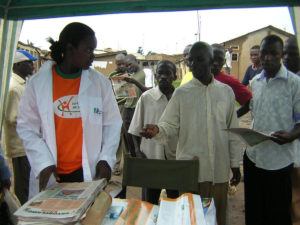Engaging
Establish a Neutral Coordinating Body
If the integrated SBCC effort involves several partners or crosses programs or sectors, a coordinating body will be essential to facilitate the work of the partners at national (and perhaps local) level. During the environmental analysis, if you discovered that a coordinating body for SBCC exists, it may be possible to take advantage of that body. This will depend on the purpose of that body, meeting frequency and amenability. Consider forming a sub-group of the existing coordinating body to manage the integrated program. Otherwise, it will be necessary to form a new group.
What is a Coordinating Body?
A coordinating body has the mandate and the authority to align the work of different implementing agencies towards a common strategy. This body may come in the form of a health or multi-sectoral partnership that includes relevant government agencies, donors, implementers and others.
What are the Roles of a Coordinating Body?
In general, a coordinating body’s purpose is to harmonize efforts, avoid overlap and ensure everyone shares a similar understanding and is progressing toward the same shared SBCC and health/development goals. The coordinating body’s level of authority may vary depending on context. Will your coordinating body have oversight, advisory, voting, decision-making and/or approval responsibilities?
Consider the following functions when determining what your coordinating body will need to do:
Tip
In addition to national-level coordination, it is important to consider how coordination will remain strong at sub-national levels. What are the different sectoral entry points at the local level? What coordinating bodies exist or should be put in place at the regional level, district level or below? How can you build upon those networks to ensure coordination?
Program Experience
(When you see a Program Experience, simply click on the photo to read insights from real integrated SBCC programs.)
How Do You Establish a Coordinating Body?
The environmental analysis should give you information about any coordinating bodies already in existence. In the event that a coordinating body (or bodies) for SBCC already exists, you may need to strengthen or adapt it to meet your needs. In other cases, a coordinating body may need to be created.
The frequency of coordination meetings will depend on the complexity of the project. Monthly or quarterly meetings are usually best, but there may be points in the project that require more frequent meetings, particularly during implementation and start-up.
Detailed guidance on organizing and conducting stakeholder workshops can be found here.
Program Experience
Who Should be a Member of the Coordinating Body?
Selecting the right members for the coordinating body is the first step to ensuring its success. It is important to be certain the coordinating body is properly constituted from the beginning, and that members consistently attend. Identify champions in each of the sectors or programs. Champions should be ready, willing and able to represent their topic and constituents well, and to identify solutions that further the shared vision.
The size of the coordinating body will depend on the number of topics in the SBCC initiative, and the number of stakeholders working in the various areas. It is not uncommon to have six or more organizations represented in a coordinating body for an integrated SBCC program. Consider the size that will allow the coordinating body to function most effectively. If it has too many members, the process may become unwieldy. Too few members will result in key gaps, and opportunities may be overlooked. Membership is rarely more than 25, and might include communication experts, representatives from each health area, implementing partners and the media.
As previously mentioned, ensure a high-ranking person convenes the partnership, and holds meetings at government offices whenever possible. Appoint an organization, individual or small team to serve as the secretariat. The secretariat is often the implementing partner leading the integrated SBCC initiative. The secretariat should be responsible for developing meeting agendas and content that efficiently uses participants’ time, and for keeping partners informed through regular reports between meetings.
Step-by-step guidance on how to develop and measure coordination and stakeholder support can be found here.
– Fayyaz Khan"We had a main counterpart in the [MOH]. She was the mover and shaker of the project. If anything didn’t work, we went to her and she would help us. We held monthly meetings. She was quite approachable. She was a senior government official, so having her blessing was quite important. At the same time, she would go to districts. Her correspondence there was quite important as well. She was helpful at both the central and district levels."
Former Chief of Party for Malawi SSDI-Communication



